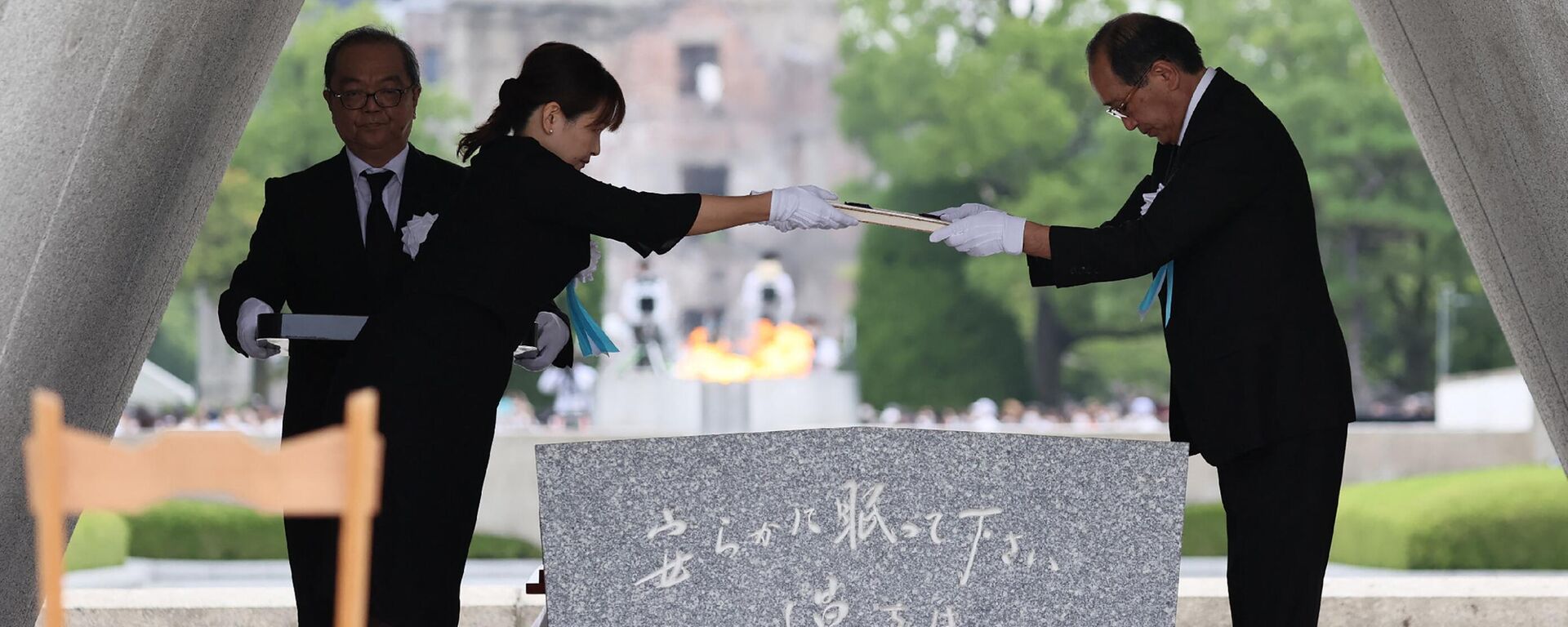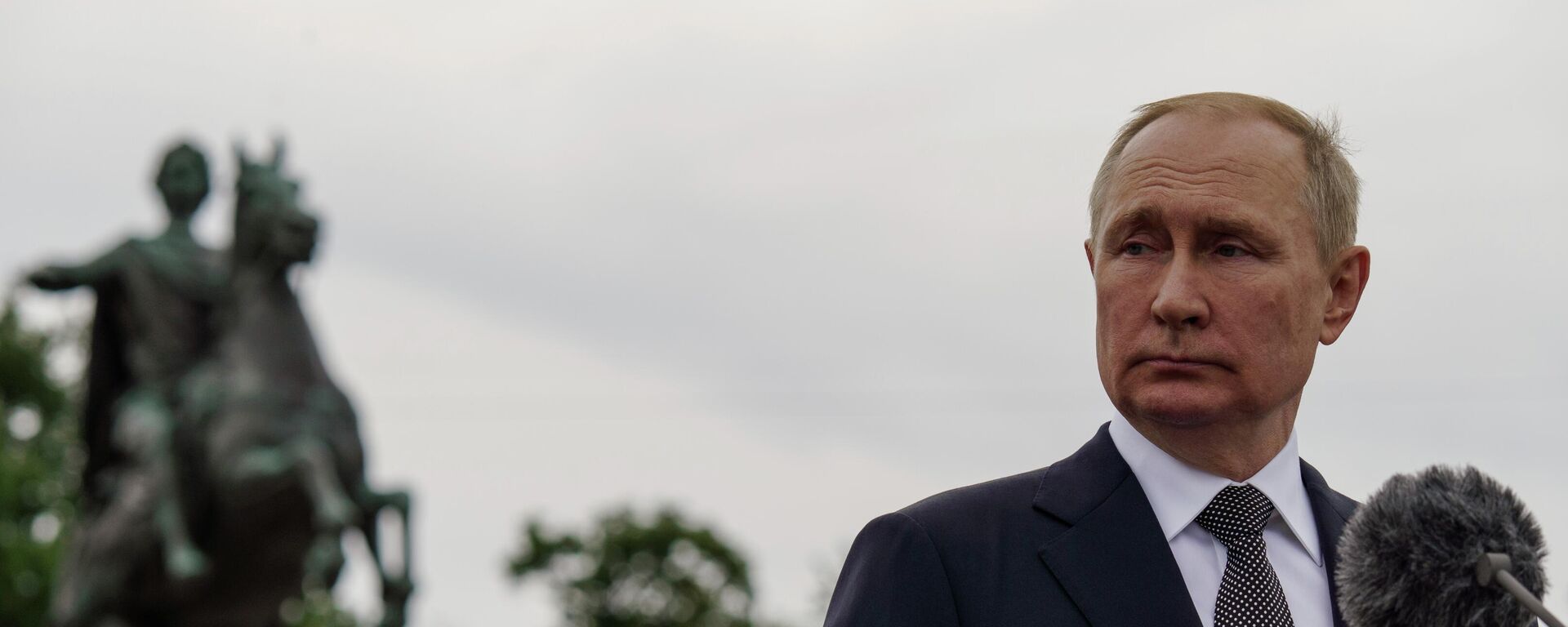https://sputnikglobe.com/20221105/why-did-us-drop-nuclear-bombs-on-japan-in-1945--1103817462.html
Why Did US Drop Nuclear Bombs on Japan in 1945?
Why Did US Drop Nuclear Bombs on Japan in 1945?
Sputnik International
The US nuclear bombings of Hiroshima and Nagasaki in August 1945 claimed the lives of at least 130,000 people and wounded thousands more. The US that remains the only country in the world to have used nuclear weapons in an armed conflict.
2022-11-05T14:59+0000
2022-11-05T14:59+0000
2023-04-06T12:15+0000
world
russia
hiroshima
nagasaki
nuclear bomb
bomber
us
japan
https://cdn1.img.sputnikglobe.com/img/07e4/08/09/1080107420_0:538:2591:1995_1920x0_80_0_0_895a5961a5cbb20678200298e744c075.jpg
With Washington not thinking twice before accusing Moscow of nuclear blackmail amid Russia’s ongoing special military operation in Ukraine, it is worth stressing that it is the US that remains the only country in the world to have used nuclear weapons in an armed conflict.Less than a month before the September 2, 1945 end of the Second World War, the US dropped nuclear bombs on the Japanese cities of Hiroshima and Nagasaki, killing at least 130,000 people. Now let’s look into what was behind Washington’s decision to drop nukes on Japan on August 6 and August 9, 1945. To better understand what prompted the US to take such a step, one should bear in mind that by the summer of 1945, America, which was Japan’s arch foe at the time, already possessed a total of three atomic bombs, including “Little Boy” and “Fat Man”, which were dropped on Hiroshima and Nagasaki, respectively.This was preceded by Japan’s attempts in the early 1940s to strengthen its clout in the Asia and Pacific region, where Tokyo attacked UK and US military bases and invaded an array of countries, including Malaysia, Burma, the Philippines, Indonesia, and New Guinea.The Japanese offensive, however, saw signs of stalling in late 1942 and a year later, British and American troops launched a counteroffensive, trying to recapture the initiative. It took American forces, though, two more years to occupy the island of Okinawa, which had become part of Japan back in 1879.The developments followed the US and the UK in 1944 clinching a deal on the possibility of using nuclear weapons against Japan. In May 1945, the so-called Target Committee at Los Alamos, New Mexico rejected the idea of launching nuclear strikes on Japanese military targets because of a possible miss and a muted “psychological effect”, something that finally prompted the US military to start considering strikes on Japanese cities.Initially, Americans planned to drop a nuclear bomb on Kyoto, but US Secretary of War Henry Stimson said “no” to the idea, citing his own warm memories spending his honeymoon in the ancient Japanese capital.On July 25, 1945, then-US President Harry Truman ordered a nuclear strike on Hiroshima, the seventh most populous city in Japan, where about 245,000 lived at the time. Almost two weeks later, all clocks in Hiroshima stopped and many turned into radioactive ash following the detonation of the “Little Boy” bomb, which was dropped by a US Air Force B-29 Superfortress bomber and exploded around 576 meters above the ground.At least 70,000 people were killed in the August 6, 1945 explosion, which was followed by a nuclear blast over Nagasaki, where at least 60,000 died on August 9 of that year. Many more were injured and subjected to radiation disease, which led to thousands of deaths in subsequent years.Nowadays, even some Western analysts reject Washington’s version that cites the alleged “military necessity” of the US’ nuclear bombings of Hiroshima and Nagasaki. Russian experts for their part believe that by dropping nukes on Japan, Truman first and foremost wanted to intimidate the Soviet Union with the destructive power of a new weapon, and secondly, he apparently looked to justify the huge costs of developing these atomic bombs.It's enough to read US archive documents on the selection of Japanese cities for nuclear annihilation to realize that Hiroshima and Nagasaki were then of paramount military importance. They did have important ports, but they were not headquarters, decision-making centers or areas where lots of Japanese soldiers were stationed, according to Russian analysts.This was once again underscored by Russian President Vladimir Putin during his speech at a plenary session of the Valdai Discussion Club in Moscow last month.He was referring to the fact that Japanese media now prefer to keep mum on who dropped deadly nuclear bombs on the Land of the Rising Sun when discussing the topic.
https://sputnikglobe.com/20220806/hiroshima-mayor-quotes-russian-writer-tolstoy-at-peace-memorial-ceremony-1098358340.html
https://sputnikglobe.com/20220801/putin-says-there-can-be-no-winners-in-nuclear-war-it-must-never-be-unleashed-1098004635.html
russia
hiroshima
nagasaki
japan
Sputnik International
feedback@sputniknews.com
+74956456601
MIA „Rosiya Segodnya“
2022
Oleg Burunov
https://cdn1.img.sputnikglobe.com/img/07e4/09/0b/1080424846_0:0:2048:2048_100x100_80_0_0_3d7b461f8a98586fa3fe739930816aea.jpg
Oleg Burunov
https://cdn1.img.sputnikglobe.com/img/07e4/09/0b/1080424846_0:0:2048:2048_100x100_80_0_0_3d7b461f8a98586fa3fe739930816aea.jpg
News
en_EN
Sputnik International
feedback@sputniknews.com
+74956456601
MIA „Rosiya Segodnya“
Sputnik International
feedback@sputniknews.com
+74956456601
MIA „Rosiya Segodnya“
Oleg Burunov
https://cdn1.img.sputnikglobe.com/img/07e4/09/0b/1080424846_0:0:2048:2048_100x100_80_0_0_3d7b461f8a98586fa3fe739930816aea.jpg
washington's nuclear blackmail accusations against moscow, russia's special military operation in ukraine, us' nuclear bombings of hiroshima and nagasaki, us development of nuclear bombs, japan’s attempts in the early 1940s to strengthen its clout in the asia
washington's nuclear blackmail accusations against moscow, russia's special military operation in ukraine, us' nuclear bombings of hiroshima and nagasaki, us development of nuclear bombs, japan’s attempts in the early 1940s to strengthen its clout in the asia
Why Did US Drop Nuclear Bombs on Japan in 1945?
14:59 GMT 05.11.2022 (Updated: 12:15 GMT 06.04.2023) The US nuclear bombings of Hiroshima and Nagasaki in August 1945 claimed the lives of at least 130,000 people and wounded thousands more.
With Washington not thinking twice before accusing Moscow of nuclear blackmail amid
Russia’s ongoing special military operation in Ukraine, it is worth stressing that it is the US that remains the only country in the world to have used nuclear weapons in an armed conflict.
Less than a month before the September 2, 1945 end of the Second World War, the US dropped nuclear bombs on the Japanese cities of Hiroshima and Nagasaki, killing at least 130,000 people. Now let’s look into what was behind Washington’s decision to drop nukes on Japan on August 6 and August 9, 1945. To better understand what prompted the US to take such a step, one should bear in mind that by the summer of 1945, America, which was Japan’s arch foe at the time, already possessed a total of three atomic bombs, including “Little Boy” and “Fat Man”, which were dropped on Hiroshima and Nagasaki, respectively.
This was preceded by Japan’s attempts in the early 1940s to strengthen its clout in the Asia and Pacific region, where Tokyo attacked UK and US military bases and invaded an array of countries, including Malaysia, Burma, the Philippines, Indonesia, and New Guinea.
The Japanese offensive, however, saw signs of stalling in late 1942 and a year later, British and American troops launched a counteroffensive, trying to recapture the initiative. It took American forces, though, two more years to occupy the island of Okinawa, which had become part of Japan back in 1879.
The developments followed the US and the UK in 1944 clinching a deal on the possibility of using nuclear weapons against Japan. In May 1945, the so-called Target Committee at Los Alamos, New Mexico rejected the idea of launching nuclear strikes on Japanese military targets because of a possible miss and a muted “psychological effect”, something that finally prompted the US military to start considering strikes on Japanese cities.
Initially, Americans planned to drop a nuclear bomb on Kyoto, but US Secretary of War Henry Stimson said “no” to the idea, citing his own warm memories spending his honeymoon in the ancient Japanese capital.
On July 25, 1945,
then-US President Harry Truman ordered a nuclear strike on Hiroshima, the seventh most populous city in Japan, where about 245,000 lived at the time. Almost two weeks later, all clocks in Hiroshima stopped and many turned into radioactive ash following the detonation of the “Little Boy” bomb, which was dropped by a US Air Force B-29 Superfortress bomber and exploded around 576 meters above the ground.
At least 70,000 people were killed in
the August 6, 1945 explosion, which was followed by a nuclear blast over Nagasaki, where at least 60,000 died on August 9 of that year. Many more were injured and subjected to radiation disease, which led to thousands of deaths in subsequent years.
Nowadays, even some Western analysts reject Washington’s version that cites the alleged “military necessity” of the US’ nuclear bombings of Hiroshima and Nagasaki. Russian experts for their part believe that by dropping nukes on Japan, Truman first and foremost wanted to intimidate the Soviet Union with the destructive power of a new weapon, and secondly, he apparently looked to justify the huge costs of developing these atomic bombs. It's enough to read US archive documents on the selection of Japanese cities for nuclear annihilation to realize that Hiroshima and Nagasaki were then of paramount military importance. They did have important ports, but they were not headquarters, decision-making centers or areas where lots of Japanese soldiers were stationed, according to Russian analysts.
This was once again underscored by
Russian President Vladimir Putin during his speech at a plenary session of the Valdai Discussion Club in Moscow last month.
“What was the necessity expediency of using a [nuclear] bomb against Japan? There wasn't any. Why did the US finish off Japan with nuclear weapons? In Japanese textbooks, they write that it was the allies [rather than the US] who conducted a strike. […], Well done, Americans, this is how they currently keep Japan,” Putin stressed.
He was referring to the fact that Japanese media now prefer to keep mum on who dropped deadly nuclear bombs on the Land of the Rising Sun when discussing the topic.








